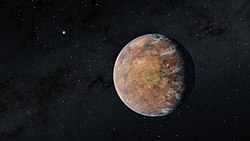Astronomy:TOI-700 e
 TOI-700 e concept art. The large blue dot on the top left is TOI-700 d. | |
| Discovery | |
|---|---|
| Discovered by | TESS |
| Discovery date | 2023 |
| Transit | |
| Orbital characteristics | |
| 0.0134 | |
| Eccentricity | 0.06 |
| Orbital period | 27.8 d |
| Star | TOI-700 |
| Physical characteristics | |
| Mean radius | 0.953 R⊕ |
| Mass | 0.818 M⊕ |
TOI-700 e is the second outermost exoplanet orbiting TOI-700, a red dwarf star in the constellation of Dorado.
Host star
TOI-700 is a red dwarf of spectral class M that is about 40% the mass and radius, and very roughly 50% of the temperature of the Sun.[1] The star is bright with low levels of stellar activity. Over the 11 sectors observed with TESS, the star does not show a single white-light flare. The low rotation rate is also an indicator of low stellar activity.[2]
Orbit
TOI-700 e orbits its host star with an orbital period of 27.8 days, comparable with the Moon's orbital period of 27.5 Earth days. It has an orbital radius of about 0.0134 astronomical unit|AU (2.00 million km; 1.25 million mi), less than half of that of Mercury to the Sun in the Solar System. It receives about 130% of Earth's sunlight from its host star.[citation needed]
Near orbital resonances
TOI-700 e is in a near orbital resonance with TOI-700 c and TOI-700 d. It is in a near 5:7 resonance with TOI-700 c and a near 3:4 resonance with TOI-700 d.[citation needed]
Discovery
| Earth | TOI-700 e |
|---|---|

|

|
In November 2021, a fourth possible planet, Earth-sized and receiving approximately 30% more flux from TOI-700 than Earth does from the Sun, was found at the inner edge of the habitable zone of TOI-700.[3] In January 2023 the existence of this planet, designated TOI-700 e, was confirmed.[4]
Discovered in 2023, TOI-700 e is terrestrial exoplanet that NASA claims to be an "earth-like" planet, with 95 percent of the Earth’s radius. Discovered by NASA's TESS (Transiting Exoplanet Survey Satellite), TOI-700 e has mass of about 0.818 Earths and takes 27.8 days to orbit once around its star.[5] The planet is in a habitable zone distance from the M-type star TOI-700 it orbits, leading NASA scientists to believe that there is potential for liquid water on its surface. Ten percent smaller than its neighboring planet TOI-700 d, both are at a distance from their sun to be considered habitable, however, TESS requires an additional year to acquire more data about the exoplanets.[6] Being one in only about a dozen habitable zone planets known, further research and data collection of the TOI-700 solar system is important for understanding Earth-like planets.[7]
References
- ↑ Wall, Mike (6 January 2020). "NASA's TESS Planet Hunter Finds Its 1st Earth-Size World in 'Habitable Zone'". Space.com. https://www.space.com/nasa-tess-first-earth-size-habitable-exoplanet-toi-700d.html.
- ↑ Gilbert, Emily A.; Barclay, Thomas; Schlieder, Joshua E.; Quintana, Elisa V.; Hord, Benjamin J.; Kostov, Veselin B.; Lopez, Eric D.; Rowe, Jason F. et al. (2020-01-03). "The First Habitable Zone Earth-sized Planet from TESS. I: Validation of the TOI-700 System". The Astronomical Journal 160 (3): 116. doi:10.3847/1538-3881/aba4b2. Bibcode: 2020AJ....160..116G.
- ↑ "ExoFOP TIC 150428135". https://exofop.ipac.caltech.edu/tess/target.php?id=150428135.
- ↑ "Second Earth-sized World Found in System's Habitable Zone". NASA. 10 January 2023. https://exoplanets.nasa.gov/news/1720/second-earth-sized-world-found-in-systems-habitable-zone/.
- ↑ Kazmierczak, Jeanette (2023-01-09). "NASA's TESS Discovers Planetary System's Second Earth-Size World". http://www.nasa.gov/feature/nasa-s-tess-discovers-planetary-system-s-second-earth-size-world.
- ↑ Kazmierczak, Jeanette (2023-01-09). "NASA's TESS Discovers Planetary System's Second Earth-Size World". http://www.nasa.gov/feature/nasa-s-tess-discovers-planetary-system-s-second-earth-size-world.
- ↑ Haghighipour, Nader (2015), Gargaud, Muriel; Irvine, William M.; Amils, Ricardo et al., eds. (in en), Kepler 186f: First Earth-Sized Planet in Habitable Zone, Berlin, Heidelberg: Springer Berlin Heidelberg, pp. 1325–1326, doi:10.1007/978-3-662-44185-5_5294, ISBN 978-3-662-44184-8, Bibcode: 2015enas.book.1530H, http://link.springer.com/10.1007/978-3-662-44185-5_5294, retrieved 2023-04-16
 |

